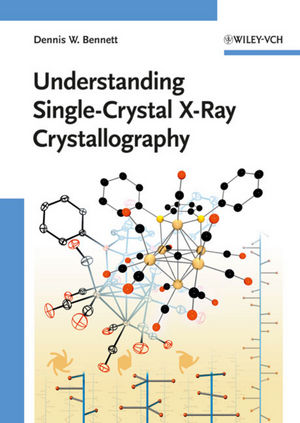Understanding Single-Crystal X-Ray CrystallographyISBN: 978-3-527-32677-8
Hardcover
831 pages
March 2010
 Other Available Formats: Paperback
|
||||||
Foreword xi
Preface xiii
Acknowledgements xvii
1 Crystal Lattices 1
1.1 The Solid State 1
1.2 The Crystal Lattice 5
1.2.1. Two-dimensional Lattices 5
1.2.2. Three-dimensional Lattices 7
1.3 Vectors in Crystallography 10
1.3.1. Geometric Vector Addition and Multiplication 11
1.3.2. Basis Vectors and Coordinates 13
1.3.3. Orthonormal Bases 19
1.3.4. The Scalar Product in an Orthonormal Coordinate System 22
1.3.5. The Vector Product in an Orthonormal Coordinate System 26
1.4 Matrices in Crystallography 28
1.4.1. Matrix Definitions 28
1.4.2. Matrix Operations 30
1.4.3. Matrix Transformations 32
1.4.4. The Determinant of a Matrix 36
1.4.5. The Inverse of a Matrix 41
1.4.6. The Rules of Matrix Algebra 44
1.4.7. The Eigenvectors and Eigenvalues of a Matrix 48
1.5 Coordinate Systems in Crystallography 51
1.5.1. Change of Basis 51
1.5.2. Transformation from the Unit Cell Basis to an Orthonormal Basis 52
1.5.3. Determining Distances and Angles In the Unit Cell 56
1.5.4. Determining the Volume of the Unit Cell 59
1.5.5. Important Identities 62
2 Crystal Symmetry 67
2.1 Symmetry 67
2.2 Symmetry Group Theory 70
2.2.1. Sets of Symmetry Operations 70
2.2.2. Symmetry Groups 75
2.3 Point Groups 78
2.3.1. Molecular Point Symmetry 78
2.3.2. Matrix Representations of Groups 80
2.3.3. Character Tables 83
2.3.4. Lattice and Crystal Point Symmetry. The Hermann-Mauguin Notation 84
2.3.5. Stereographic Projections: Crystallographic Point Symmetry Elements 88
2.3.6. The 32 Crystallographic Point Groups 94
2.3.7. The Symmetry Classification of Crystal Systems 107
2.4 Space Groups 119
2.4.1. Translational Symmetry 119
2.4.2. Crystal Space Symmetry 120
2.4.3. The Triclinic Space Groups 126
2.4.4. The Monoclinic Space Groups 128
2.4.5. The Orthorhombic Space Groups162
2.4.6. The Trigonal Space Groups 169
2.4.7. The Tetragonal Space Groups 175
2.4.8. The Hexagonal Space Groups 180
2.4.9. The Cubic Space Groups 184
2.4.10. General Considerations 189
3 Crystal Diffraction: Theory 195
3.1 Electromagnetic Radiation 195
3.1.1. The Electric Field 195
3.1.2. Waves 196
3.1.3. Particles 199
3.1.4. Interference 201
3.2 Diffraction 204
3.2.1. The Reciprocal Lattice 209
3.2.2. X-ray Diffraction: The Diffraction Equation 225
3.2.3. X-ray Diffraction: The Electron Density Equation 238
3.2.4. X-ray Diffraction: The Spherical Atom Approximation 249
3.2.5. Calculating Structure Factors and Electron Density 257
4 Crystal Diffraction: Experiment 265
4.1 The Sphere of Reflection 265
4.2 Recording the Diffraction Pattern: Film Methods 267
4.3 Recording the Diffraction Pattern: Counter Methods 275
4.3.1. Serial Detectors 275
4.3.2. Area Detectors 285
4.4 Determining the Orientation Matrix and Unit Cell 289
4.5 Refining the Orientation Matrix and Unit Cell 296
4.6 Determining the Bravais Lattice 299
4.6.1. Reduction of the Unit Cell 299
4.6.2. Searching for Higher Lattice Symmetry 305
4.6.3. Symmetry of the Reciprocal Lattice 309
4.7 The Measurement of Integrated Intensities 313
4.7.1. Reflections 313
4.7.2. The Integrated Intensity 315
4.7.3. Intensities From Serial Detectors 324
4.7.4. Intensities From Area Detectors 326
4.7.5. Limits to the Collection of Intensity Data 329
5 Crystal Diffraction: Data 339
5.1 Experimental Error 339
5.1.1. Random Error 340
5.1.2. Systematic Error 378
5.2 Scaling the Intensity Data 465
5.3 Determining the Space Group 471
5.3.1. Systematic Absences 472
5.3.2. Intensity Statistics .478
6 Crystal Structure Solution: Experimental 497
6.1 The Patterson Function 497
6.1.1. Patterson Solution: Structures Without Heavy Atoms 506
6.1.2. Patterson Solution: Structures With Heavy Atoms 515
6.1.3. Patterson Solution: Search Methods 527
6.2 Other Experimental Methods 537
6.2.1. The Isomorphous Replacement Method 537
6.2.2. The Anomalous Dispersion Method 545
6.3 Completion of the Structural Solution: Fourier Methods 549
6.3.1. Electron Density Synthesis 550
6.3.2. Difference Electron Density Synthesis 557
6.3.3. The Completion of Macromolecular Structures 565
7 Crystal Structure Solution: Statistical 571
7.1 Direct Methods 571
7.1.1. Probability Methods: Structure Invariants 573
7.1.2. Probability Methods: Initial Phases 600
7.1.3. Probability Methods: Solving the Structure 621
7.2 Other Direct Methods 662
7.2.1. Dual-Space Iteration 663
7.2.2. Maximum Entropy 664
7.3 Completion of the Structural Solution: Probability Methods 665
7.3.1. Phases fromFourier Structure Factors 666
7.3.2. Phases fromDifference Fourier Structure Factors 669
8 Crystal Structure Refinement 673
8.1 Linear Least Squares 673
8.1.1. Weighted Least Squares 678
8.1.2. Estimation of Parameter Errors 679
8.1.3. Constrained Least Squares 688
8.1.4. Restrained Least Squares 692
8.2 Non-linear Least Squares: Structure Refinement 693
8.2.1. Weights in Refinement 698
8.2.2. Estimation of Parameter Errors in Refinement 703
8.2.3. Refinement Figures of Merit 708
8.2.4. Constrained Refinement 710
8.2.5. Restrained Refinement 722
8.2.6. The Refinement of Twinned Structures 724
8.2.7. The Refinement of Chiral Structures 726
8.3 Macromolecular Refinement 729
8.3.1. Heavy Atom Solutions 729
8.3.2. Molecular Replacement Solutions 732
8.3.3. Completion of the Model 734
8.3.4. Refinement of the Model 737
Appendix
A A Geometric Derivation of Bragg’s Law 747
B The Fourier Transform: Electron Density & The Structure Factor 749
C Determination of the Phase Parameter in the Amplitude Reflectivity Ratio 753
D Reflection From a Single Plane 755
E A Discussion of Kinematical Models for Extinction 763
F Probability Integrals: The Modified Bessel Function 767
G Monte Carlo Optimization – A Simple Example 773
H Constrained Optimization 777
I Taylor Series 787
Bibliography 789
Index 801



